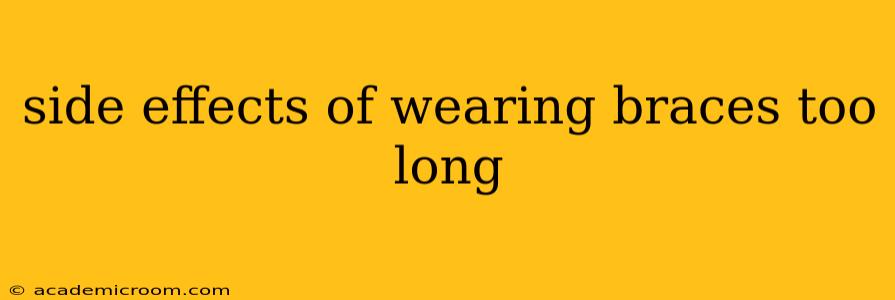Wearing braces is a common orthodontic treatment to straighten teeth and improve bite alignment. While generally safe and effective, prolonged brace wear can lead to certain side effects. This comprehensive guide explores potential issues associated with extended brace treatment, addressing common concerns and providing valuable insights for patients and orthodontists.
What Happens If Braces Are Worn Too Long?
The ideal duration of brace treatment varies depending on individual cases, typically ranging from 12 to 36 months. While exceeding this timeframe isn't inherently dangerous, it can increase the risk of several complications. Prolonged pressure from the braces can affect the supporting structures of the teeth, potentially leading to:
-
Root Resorption: This is perhaps the most significant concern. Prolonged orthodontic force can cause the roots of the teeth to shorten or dissolve. While minor root resorption often doesn't affect the tooth's functionality, significant resorption can weaken teeth and increase the risk of future problems.
-
Gum Recession: Excessive pressure from the braces can push the gums away from the teeth, exposing more of the root surface. This can lead to gum recession, making teeth more sensitive and susceptible to decay.
-
Increased Tooth Sensitivity: Many patients experience some tooth sensitivity during orthodontic treatment. However, prolonged wear can exacerbate this, leading to heightened discomfort and sensitivity to hot and cold temperatures.
-
De-mineralization: The constant pressure and friction from braces can disrupt the enamel, leading to demineralization, or the weakening of the tooth's outer layer. This increases the risk of cavities and discoloration.
-
Increased Risk of Cavities: Braces make it slightly more difficult to clean teeth thoroughly. If proper oral hygiene isn't maintained throughout the treatment, the extended duration increases the risk of developing cavities.
-
Jaw Pain and discomfort: While the primary reason for the discomfort typically relates to the teeth adjusting, if the brackets cause pressure on the jaw, it can lead to discomfort.
Is it Harmful to Wear Braces for More Than 3 Years?
Wearing braces for longer than three years isn't inherently harmful, but the risks mentioned above become more pronounced with prolonged treatment. The key factor isn't just the duration, but also the intensity and type of orthodontic forces applied. An experienced orthodontist will carefully monitor the treatment's progress and adjust the forces as needed to minimize the risk of complications.
How Long is Too Long to Wear Braces?
There's no single answer to how long is "too long." The optimal treatment duration is determined by various factors including:
- Severity of the malocclusion (misalignment): More severe cases naturally require longer treatment times.
- Patient's cooperation: Consistent adherence to instructions regarding oral hygiene and retainer wear significantly impacts treatment speed.
- Age of the patient: Younger patients often respond faster to treatment than older ones.
- Type of orthodontic appliances: Different types of braces may lead to varying treatment times.
Your orthodontist will regularly assess your progress and determine the appropriate treatment duration. If the treatment is taking longer than anticipated, they'll discuss any potential risks and adjust the treatment plan accordingly.
What are the signs that your braces need to be removed?
Your orthodontist will be the best judge, but generally, if you notice any excessive pain or discomfort unrelated to the typical adjustment periods, gum recession, sensitivity, or other issues described above, it's time to schedule a check-up.
Can wearing braces for too long cause permanent damage?
While prolonged brace wear can cause permanent damage in extreme cases (such as significant root resorption), this is relatively rare. Regular monitoring and adjustments by your orthodontist are key to minimizing any long-term effects.
Conclusion
While extended brace treatment might increase the risk of certain side effects, it's crucial to remember that the benefits of achieving a well-aligned bite often outweigh the potential drawbacks. Regular check-ups with your orthodontist are essential to monitor progress and address any concerns promptly. Open communication with your orthodontist ensures that you receive the best possible care and minimize the risk of complications.
